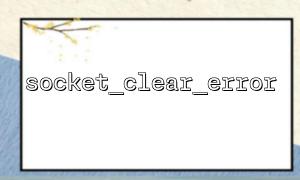In PHP network programming, the socket_accept() function is used to accept a client's connection request, and connection exceptions or errors will inevitably occur during network communication. Using the socket_clear_error() function rationally can help us clean up the error state and avoid exceptions interfering with subsequent connection processing. This article will introduce in detail how to combine these two functions to improve the stability and robustness of the server side.
socket_accept() is a function in the PHP Socket extension that accepts client connections to a socket that is already in the listening state. Its return value is a new socket resource that represents the connection to the client.
Sample code:
$clientSocket = socket_accept($serverSocket);
if ($clientSocket === false) {
echo "Accept failed: " . socket_strerror(socket_last_error($serverSocket)) . "\n";
} else {
echo "Client connected.\n";
}
When calling socket_accept() , if the client connects abnormally or has a network problem, the function may return false and an error code will be generated.
socket_clear_error() is a new function added in PHP 7.4 to clean up error status on a socket resource. When an error occurs in a socket, the error status will always exist, which may cause interference to subsequent calls.
By calling socket_clear_error() , the error status on the socket can be cleared to ensure that the next operation can proceed normally.
The syntax is as follows:
bool socket_clear_error(resource $socket, int $flags = 0)
The parameter $flags is optional, the default value is 0, indicating that all errors are cleaned.
When accepting connections using socket_accept() , if there is a connection exception (such as abnormal client disconnection, network interruption, etc.), an error state will remain on the listening socket. If the error is not cleaned up in time, the next call to socket_accept() may fail, affecting server stability.
At this time, calling socket_clear_error() to clean up the error state can prevent the new connection from being blocked due to old errors.
Here is an example showing how to accept client connections in a loop while cleaning up possible error status:
$serverSocket = socket_create(AF_INET, SOCK_STREAM, SOL_TCP);
socket_bind($serverSocket, '0.0.0.0', 8080);
socket_listen($serverSocket);
while (true) {
$clientSocket = socket_accept($serverSocket);
if ($clientSocket === false) {
// Get and print the error message
$errorCode = socket_last_error($serverSocket);
$errorMsg = socket_strerror($errorCode);
echo "Accept failed: [$errorCode] $errorMsg\n";
// Clean up the error status,Avoid blocking subsequent connections
socket_clear_error($serverSocket);
// Available for short sleep,Avoid rapid error reporting in the dead cycle
usleep(100000);
continue;
}
echo "Client connected.\n";
// Code for handling client connections
// ...
socket_close($clientSocket);
}
In this code, if socket_accept() returns false , the error message is printed and socket_clear_error() is called to clean up the error status on the listening socket. This ensures that the server can continue to accept new connection requests.
socket_clear_error() is only valid for specific socket resources and cannot be used for non-socket resources.
After cleaning up the errors, try to avoid ignoring all errors. It is recommended to print or record the error log for easier post-temptation.
If the program is very sensitive to connection exceptions, you can consider adding restart listening logic after socket_clear_error() to enhance robustness.
socket_accept() is used to receive client connections, but may cause error blocking in network exceptions. Combined with socket_clear_error() , the error status can be cleaned in time, ensuring that the server receives subsequent connections normally and improving stability.
This combination is a good practice in PHP Socket programming in production environments, and it is recommended that developers master it and use it reasonably.













